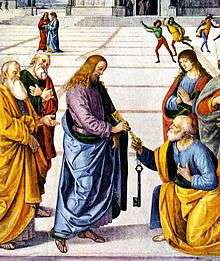Cardinal protector
| Part of a series on the |
| Hierarchy of the Catholic Church |
|---|
 |
| Ecclesiastical titles (order of precedence) |
|
|
Liturgical titles |
|
Administrative and pastoral titles
|
|
Consecrated and professed titles |
|
Organization titles |
|
|
Since the thirteenth century it has been customary at Rome to confide to some particular Cardinal a special solicitude in the Roman Curia for the interests of a given religious order or institute, confraternity, church, college, city, nation etcetera. Such a person is known as a Cardinal Protector. He was its representative or orator when it sought a favor or a privilege, defended it when unjustly accused, and besought the aid of the Holy See when its rights, property or interests were violated or imperiled.
Antecedents
- See also Protector (title)
In ancient Rome a similar relationship had existed between the client (cliens) and his patronus (hence 'patron'); as Rome's power grew, a still closer analogy is visible between the Roman institution and the modern ecclesiastical protectorate. Nearly every provincial city had its patronus, or procurator, in imperial Rome, usually a Roman patrician or eques, and such persons were held in high esteem. Thus Cicero was patronus of Dyrrachium (later Durazzo, now Durrës) and of Capua, in which Campanian city a gilded statue was raised to him. In time the office became hereditary in certain families; Suetonius wrote, in his life of Tiberius, that the [imperial] Claudian family (gens Claudia) was from ancient times protector of Sicily and the Peloponnesus.[1]
Titular churches
Every cardinal (except a Cardinal-Patriarch) is also, since the reign of John Paul II, called the Cardinal protector of the title (titular church s.s. for a Cardinal priest or Cardinal-deaconry for a Cardinal deacon) in or near Rome which he is assigned to, which gives him his title and benefits from his material support for upkeep or restoration, especially when he holds a rich see (usually as Archbishop).
Church history
The Roman Church adopted this, with many other imperial institutions, as one serviceable for external administration, not that the popes who first conferred this office and title sought to copy an ancient Roman usage, but because analogous conditions and circumstances created a similar situation. The office is conferred by the pope through the Cardinal secretary of state, sometimes by spontaneous designation of the Pope, sometimes at the request of those who seek such protection. Such a cardinal protector had the right to place his coat-of-arms on the church or main edifice of the institute, or on the municipal palace of the city in question.[1]
The first to hold such an office was Cardinal Ugolino Conti (later Pope Gregory IX), who sought thereby to paralyze the intrigues of his many enemies at Rome; at the request of St. Francis himself, he was named protector of the Franciscans by Pope Innocent III, and again by Honorius III. Alexander IV and Nicholas III retained for themselves the office of protector of the Franciscans. Indeed, the latter were long the only order that boasted of a cardinal protector; it was only in the fourteenth century that gradually the office was extended. As early as 1370 Pope Gregory XI was obliged to restrain the abuses committed by the cardinal protector of the Franciscans; Pope Martin V (1417-31) forbade the acceptance by the protector of a religious order of any payment for his protection. While Sixtus IV and Julius II defined more particularly the limits of the office, Pope Innocent XII (1691-1700) must be credited with a lasting regulation of the duties and rights of a cardinal protector.[1]
Kingdoms, empires etc. were required to have cardinal protectors until Pope Urban VI (1378-89) forbade such cardinals to receive anything from the respective sovereigns of these states, lest through love of money they should be led to abet works of injustice. In 1424 Martin V forbade the cardinals to accept the protectorate of kings and princes, which prohibition was renewed in 1492 by Alexander VI. This prohibition was not renewed by Pope Leo X in the ninth session of the Lateran Council of 1512; the cardinals, however, were urged to exercise the office in an impartial way and without regard to man. Until the Portuguese Revolution of 1910, the Kingdom of Portugal was the only state with a cardinal protector.
Roman curia
Within the papal Roman curia, a cardinal is also appointed as protector of the Pontifical Ecclesiastical Academy, which trains papal diplomats.
See also
- Cardinal protector of England
- Cardinal-Infante (disambiguation)
- Cardinal-nephew
- Crown cardinal
- Lay cardinal
References
Sources
- Girolamo Piatti (Hieronymus Platius), Tractatus de cardinalis dignitate et officio 4th edition edited by Giovanni Andrea Tria (Rome, 1746), pp. 423-436.
- William Humphrey, SJ, Urbis et Orbis: Or, The Pope as Bishop and as Pontiff (London: Thomas Baker 1899).
- J. Wodka, Zur Geschichte der nationalen Protektorate der Kardinäle an der römischen Kurie (Innsbruck-Leipzig 1938).
- J. Wicki, "Rodolfo Pio da Carpi, erster und einziger Kardinalprotektor der Gesellschaft Jesu," Miscellanea Historiae Pontificiae: Saggi storici intorno alpapato dei Professori della Facoltà di Storia ecclesiastica (Rome, 1959), pp. 243–267.
- Stephen L. Forte, Cardinal-Protector of the Dominican Order (Roma 1959).
- Olivier Poncet, "The Cardinal-Protectors of the Crowns in the Roman Curia during the first half of the Seventeenth Century: The Case of France," Gianvittorio Signorotto and Maria Antonietta Visceglia, ed. (2002). Court and Politics in Papal Rome, 1492–1700. Cambridge: Cambridge University Press. ISBN 978-1-139-43141-5., pp. 158-176.
- Martin Faber, "Gubernator, protector et corrector. Zum Zusammenhang der Entstehung von Orden und Kardinalprotektoren von Orden in der lateinischen Kirche," Zeitschrift für Kirchengeschichte 115 (2004) 19-44.
- Walsh, Katherine (1974). "The Beginnings of a National Protectorate: Curial Cardinals and the Irish Church in the Fifteenth Century". Archivium Hibernicum. 32: 72–80. JSTOR 25529601. Retrieved 2016-11-26. (Registration required (help)).